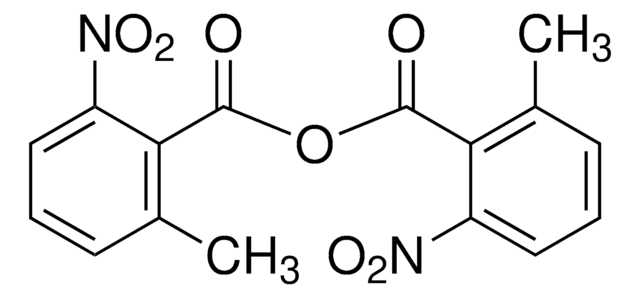Kluczowe dokumenty
107700
4-(Dimethylamino)pyridine
ReagentPlus®, ≥99%
Synonim(y):
N,N-Dimethylpyridin-4-amine, DMAP
About This Item
Polecane produkty
klasa czystości
reagent grade
Poziom jakości
linia produktu
ReagentPlus®
Próba
≥99%
Formularz
chips
crystalline powder
flakes
stężenie
≤100%
pH
(10,23 at -0,1 g/l at 22 °C)
bp
162 °C
mp
108-110 °C (lit.)
rozpuszczalność
H2O: 50 mg/mL
grupa funkcyjna
amine
temp. przechowywania
room temp
ciąg SMILES
CN(C)c1ccncc1
InChI
1S/C7H10N2/c1-9(2)7-3-5-8-6-4-7/h3-6H,1-2H3
Klucz InChI
VHYFNPMBLIVWCW-UHFFFAOYSA-N
Szukasz podobnych produktów? Odwiedź Przewodnik dotyczący porównywania produktów
Powiązane kategorie
Opis ogólny
Zastosowanie
- To synthesize 3,5-disubstituted 2,6-dicyanoaniline by reacting malononitrile, aldehydes, and β-nitroolefins.
- For the acylation of alcohols with acid anhydrides under auxiliary base- and solvent-free conditions to synthesize corresponding esters.
- In Baylis-Hillman reaction to form carbon-carbon bond by the coupling of an activated alkene with an aldehyde or ketone.
Informacje prawne
Hasło ostrzegawcze
Danger
Zwroty wskazujące rodzaj zagrożenia
Zwroty wskazujące środki ostrożności
Klasyfikacja zagrożeń
Acute Tox. 2 Dermal - Acute Tox. 3 Inhalation - Acute Tox. 3 Oral - Aquatic Chronic 2 - Eye Dam. 1 - Skin Irrit. 2 - STOT SE 1
Organy docelowe
Nervous system
Kod klasy składowania
6.1A - Combustible acute toxic Cat. 1 and 2 / very toxic hazardous materials
Klasa zagrożenia wodnego (WGK)
WGK 3
Temperatura zapłonu (°F)
255.2 °F
Temperatura zapłonu (°C)
124 °C
Środki ochrony indywidualnej
Eyeshields, Faceshields, Gloves, type P3 (EN 143) respirator cartridges
Wybierz jedną z najnowszych wersji:
Masz już ten produkt?
Dokumenty związane z niedawno zakupionymi produktami zostały zamieszczone w Bibliotece dokumentów.
Klienci oglądali również te produkty
Global Trade Item Number
| SKU | GTIN |
|---|---|
| CDS001275-1G | 4061825962719 |
| 107700-25KG | |
| 107700-5KG | 4061833458617 |
| 107700-100G | 4061835554058 |
| 107700-10KG | |
| 107700-1KG | |
| 107700-25G | 4061835554065 |
| 107700-500G | 4061838675477 |
| 107700-5G | 4061835554072 |
Nasz zespół naukowców ma doświadczenie we wszystkich obszarach badań, w tym w naukach przyrodniczych, materiałoznawstwie, syntezie chemicznej, chromatografii, analityce i wielu innych dziedzinach.
Skontaktuj się z zespołem ds. pomocy technicznej







![1,8-Diazabicyclo[5.4.0]undec-7-ene 98%](/deepweb/assets/sigmaaldrich/product/structures/120/564/5b373e23-1624-489c-8efb-692de0f96ffb/640/5b373e23-1624-489c-8efb-692de0f96ffb.png)





